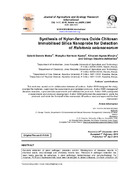Synthesis of Nylon-ferrous Oxide Chitosan Immobilised Silica Nanoprobe for Detection of Ralstonia solanacearum

View/
Date
2016Author
Wanjiru, Kihurani Agnes
Adhiambo, Odingo Dezzline
Njuma, Wanyika Harrison
Maina, Gatahi Dennis
Metadata
Show full item recordAbstract
Accurate detection of plant pathogen precedes control. Misdiagnosis of diseases results in chemical waste, crop damage and ultimately income loss. Precision in pathogen detection has been made possible by advances in plant pathology, biotechnology and nanotechnology. For instance, PCR and fluorescent kits have been developed to detect diseases. On-farm utilisation of the aforementioned technologies has been limited by the expertise required and cost. Colorimetric nanoprobes have been applied in detection of water pathogens and heavy metals. This study entailed development of nylon-ferrous oxide chitosan-silica nanoprobe for Ralstonia solanacearum pathogen. Electrospun nanofibres were used as support for ferrous oxide chitosan immobilised silica nanocomposite (FeOCISNC) gel. The materials were selected due to their compatibility, large surface area for microbial adsorption and high affinity of iron by R. solanacearum bacteria. Optimisation experiments were carried out to determine the concentration of components and pH that yielded highest iron oxide nanoparticles (FeONPs). There was significantly high yield (P=.05) when a ratio of 2:3 (v/v) for green tea extract to iron chloride solution and a pH of 6 were used. Synthesised composites were characterised using X-ray powder difraction (XRD). The resulting nanomaterials had crystallite sizes of 3.96, 5.00 and 11.60 nm for FeONPs, FeOCISNC and nylonFeOCISNC respectively. Detection of R. solanacearum was marked by colour change from grey to brown in the presence of the isolated pathogen. This was also corroborated by XRD characterisation; the nanoprobe adsorbed pathogen had a crystallite size of 14.75 nm. Additionally, the time required for optimal adsorption of FeOCISNC gel and pathogen suspension on the nylon nanofiber and nylon-FeOCISNC probe respectively was determined using optical density (O.D) of the suspensions after adsorption. There was no significant difference (P=.05) in the O.D of FeOCISNC gel when nylon nanofibres were immersed for 8 hr, 16 and 48 hr. Also, the O.D of the pathogen suspension was not significantly different (P=.05) after 5, 30 and 60 min which validated the observation that the change in colour intensity from grey to brown on the nanoprobe was not visually different within the time period. The colour change was attributed to the disruption of the pathogen membrane by glucosamine units in chitosan followed by complexation, absorption and reduction of iron oxide. Absorption of iron from the nanocomposite was due to the high affinity for iron by the bacteria. It can be concluded that, the combination of ferrous oxide and chitosan silica nanocomposites gel produced a rapid, precise and user friendly tool for detection of the lethal pathogen. The precise detection will consequently form the basis for the pathogen control.